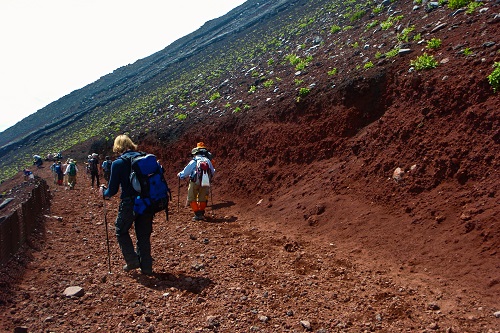The first rays of light burst over the horizon, bathing the clouds below in pink, orange and gold. Here and there jagged peaks poked through the sea of clouds, all seeming small and insignificant compared to the lofty heights of Mount Fuji, our sacred perch. The sun finally appeared and still everyone was dumbstruck. We watched in awe as the gleaming blood-red orb gradually crept higher and higher. The feeling of being on top of the world only heightened as the dawn light gradually unveiled our surroundings.
Every summer, thousands make the lengthy climb to the summit of Japan's highest peak, Mount Fuji. It's an important rite of passage for most Japanese and a popular challenge for tourists. We saw everyone from school groups to pensioners on our journey to the top.
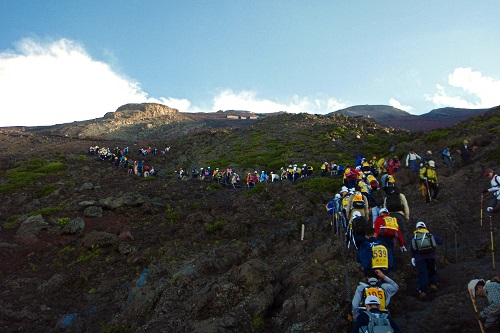
An Adventurous School Trip
The Traditional Route Up Mount Fuji
The traditional route begins at Sengen Shrine in nearby Fuji Yoshida. In years gone by, pilgrims on horseback traversed the relatively flat road to Umagaeshi at the base of the mountain. Here, the riders dismounted and continued on foot. We started our climb at Umagaeshi following a clearly defined dirt track. The path gently wove uphill through the forest, passing the occasional dilapidated wooden hut.
Above the fifth station, the landscape of Mount Fuji changed dramatically as the deciduous forest suddenly gave way to barren, rocky slopes. The bleak landscape was brightened by the rainbow of hikers zig-zagging back and forth. There were also piles of bells, each on a brightly coloured ribbon, left as offerings to the divine spirits of the volcano.
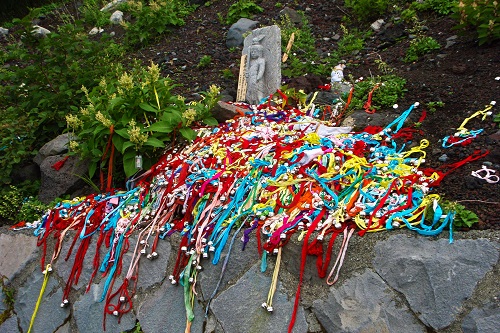
Offerings to the Volcano
Avoiding Altitude Sickness On Mount Fuji
Passing the sixth station, we found ourselves breathing unusually heavily, one of the first signs of altitude sickness. We walked increasingly slowly until we found a pace were we weren't getting out of breath. Barely putting one foot in front of the other, we crawled up the mountainside heading towards the hut where we had booked a bed.
After a very basic dinner of a hamburger steak and rice, we tried to get some sleep. Elbow to elbow with the people either side of us, we slept in a very narrow space on a communal sleeping platform. We were lulled to sleep by the rattling hiss of our neighbour noisily sucking oxygen from a small, portable cannister.
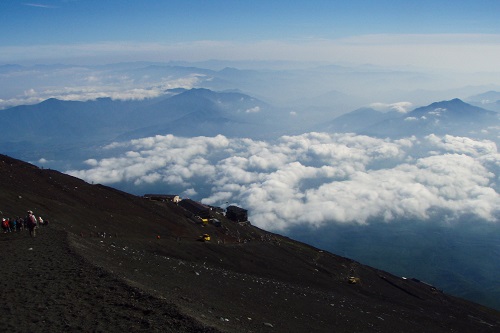
Huts Above The Clouds
Mount Fuji's Late Night Traffic Jam
We rose just a few hours later, feeling much refreshed and better adjusted to the altitude. Strapping on our head torches, we joined the slow-moving queues gradually trekking through the darkness towards the summit. We ended up walking behind a tour group who were following their guide up the mountain. Taking carefully scheduled breaks at regular intervals, the entire group repeatedly sat down right across the middle of the path. As there was no way past them, we took the opportunity to have a break too.
Around the eighth station we passed through the clouds and suddenly found ourselves up among the stars. The night sky was spectacular. Watching the lightning flashes of a thunderstorm illuminating the clouds below just added to the experience.
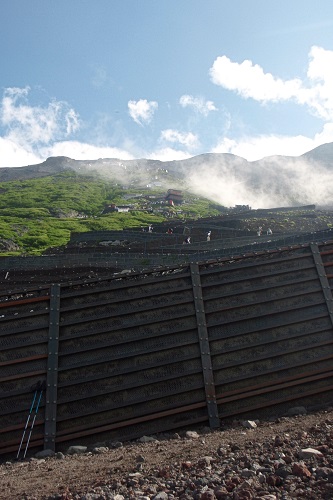
The Path To The Top
While most people were enjoying their walk to the top, we saw a few suffering from the effects of altitude sickness. Two unhappy girls crouched at the side of the path, desperately begging for oxygen. Further up, we encountered a man rushing to the summit. He pushed us out of the way as he barrelled past using a short rope to drag his partner up the hill. Just a few minutes later, we saw them again. They hadn't made it to the top and his partner was curled up in a ball, crying.
The Summit of Mount Fuji
Arriving at the summit, we were surprised to see a wall of vending machines glowing in the darkness beside a number of low-lying buildings. A steady stream of lights snaked up the mountainside below and more and more hikers made their way through the torii gate. Many purchased hot drinks or had their souvenir hiking staffs branded with the summit stamp. They then took their place among the crowds covering the eastern side of Mount Fuji.
We sat comfortably, gently stretching out our tired legs and watching the steam rising from our cups. Surrounded by hundreds of like-minded individuals, we all waited in quiet anticipation for the best views of the sunrise.
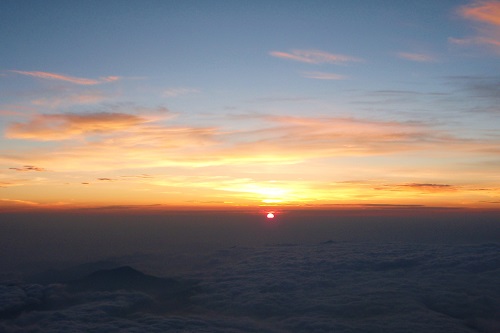
Sunrise From The Summit
A Walk Around The Crater
Once the famed spectacle was over, we continue our exploration around the crater. Even in the height of summer, we saw patches of snow and delighted in crunching through them. We saw more torii gates too, some with coins jammed into the wood for luck.
Stopping at the post office, mainly because we couldn't believe there was one, we sent a postcard marked with the official summit stamp. We also took time to admire Fuji no Kage, the shadow of Mount Fuji, a large and perfectly symmetrical conical blot across the landscape. The true summit is marked by a small stone pillar. It was easily located by the long orderly queue of Japanese waiting their turn for a photo opportunity.
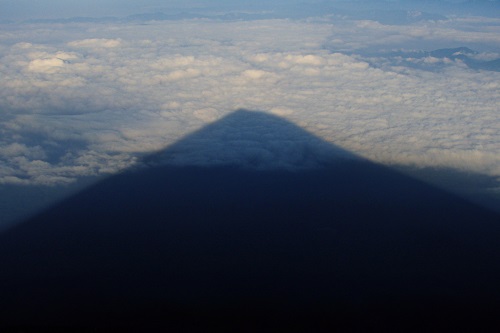
The Shadow of Mount Fuji
Tackling Mount Fuji in the summer climbing season, with the crowds, huts and vending machines on the summit, is a truly Japanese hiking experience. It can be challenging but with careful preparation it should be achievable for most moderately fit people. Watching the sunrise, whether you made it all the way to the top or not, is a unique experience and worth the physical effort required to get there. Just remember the old Japanese proverb 'A wise man climbs Mount Fuji once, only a fool climbs it twice'.
You can see great views of Mount Fuji from Hakone. Read more here.
Mount Fuji Travel Tips
The official climbing season usually runs from early July to early September. Check the Mount Fuji website for the exact dates. Climbing outside of the official climbing season can be extremely dangerous. Also, none of the huts or facilities will be open at other times of year.
If you are short on time or keen to save your energy, take a bus as far as the fifth station and climb from there.
Regardless of how fast you usually walk, your speed will be limited by the crowds, especially at night. Allow plenty of extra time.
Take plenty of food and water with you. There are some shops selling drinks and snacks on Mount Fuji but these are extremely expensive. Take some cash with you anyway, just in case you do need to buy something.
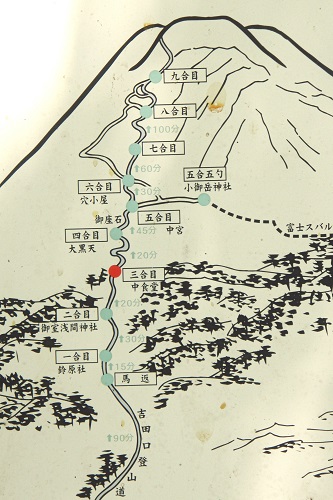
A Route Map En Route
Altitude Sickness On Mount Fuji
A shortness of breath was the first sign of altitude sickness that we noticed. A friend, who has guided several tour groups up Mount Fuji, advised us that it's better to take your time, go slowly and try not to get out of breath. If you're barely putting one foot in front of the other and you're still short of breath, you're moving too fast.
Taking a tea break or even better, sleeping for a few hours at one of the huts will help you adjust to the altitude. A reservation at a hut usually includes a basic dinner and a small space in a shared sleeping area. Space at the huts is very limited and in high demand so book early. As there are several routes up Mount Fuji, make sure you book a hut that is on the path you plan to take.
Ultimately, if you feel unwell, descend. You can always rest for a while, acclimatise, and try again later.
